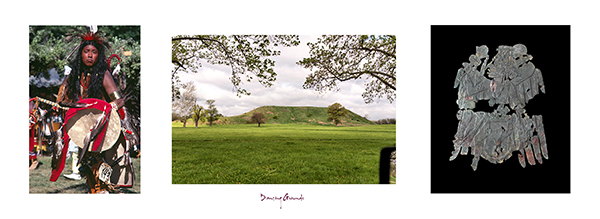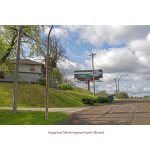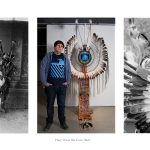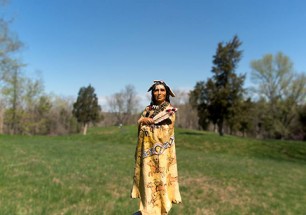Strong Hearts: My Journey with Birdman
Click on anchor points to view corresponding panel and title. You can move the map around by clicking and dragging. View a larger version of the map by clicking on the [ ] brackets on the top right of the map.
1. Battlefield (2016) pigment print on archival paper
KEY TO IMAGES (left to right)
Jeff Thomas, Petey Parsian, Nakota/Ojibway/Cree, Oka March (1990) Winnipeg, Manitoba, Smith Street. GPS: 49.89351, -97.14179
Jeff Thomas, Petey Parsian, Nakota/Ojibway/Cree, Powwow, Weston Memorial Community Centre Rink (1990) Winnipeg, Manitoba. GPS: 49.92092, -97.1925
Jeff Thomas, Petey Parsian, Nakota/Ojibway/Cree, Powwow, Weston Memorial Community Centre Rink (1990) Winnipeg, Manitoba. GPS: 49.92092, -97.1925
2. Before & After (2018) pigment print on archival paper
KEY TO IMAGES (left and right):
Jeff Thomas, Joseph Crowe, Saulteaux, University of Manitoba Graduation Powwow (1991) Winnipeg, Manitoba. GPS: 49.8075, -97.13662
3. One Of The Past (2009/2018) pigment print on archival paper
KEY TO IMAGES (left to right):
“One of the Past,” A Cree Man (1904) Saskatchewan, Institution: courtesy of G.E. Fleming / Library and Archives Canada / C-006973
Jeff Thomas, Terrance Rain, Cree (1991) Convention Centre of Winnipeg, Winnipeg, Manitoba. GPS: 49.88893, -97.14466
4. Get Up And Dance (2010) pigment print on archival paper
KEY TO IMAGES (left to right):
Brown, Ske-O-Ke-Mow (Earth Chief) (1921) Wetaskiwin, Saskatchewan, Institution: courtesy John A. Brown/ Library and Archives Canada/PA-030780
Jeff Thomas, Jack Moore, Pima Nation (1983) Grand River Powwow, Six Nations of the Grand River, Ontario. GPS: 43.11436, -80.11234
5. Birdman’s Crossing Place (Oshawa) (2005/2017) pigment print on archival paper
TRAVELOGUE: Oshawa, September 21, 2005, 11:34, parking lot of Leisure Lanes Bowling
I made an unplanned stop this morning to photograph a train idling on a bridge over Highway 401. While waiting for the train to move, I had an unexpected encounter. I was watching a flock of small birds fly towards me and I just happened to click the shutter release on my camera as they passed by. After landing in nearby small tree near me, a small hawk flew into the tree and came out with one of the birds in his talons. The hawk landed by my feet; but when I moved I frightened the hawk and it lost its grip on the bird. Both birds flew away. I also noticed a crow flying overhead, maybe waiting to steal the hawk’s meal. There was a message in this encounter and it inspired my journey to find the Birdman.
TRAVELOGUE (Taken from Edward Curtis’ Volume 1 The North American Indian, page xvi – 1907): At the moment I am seated by a beautiful brook that bounds through the forests of Apacheland. Numberless birds are singing their songs of life and love. Within my reach lies a tree, felled only last night by a beaver, which even now darts out into the light, scans his surroundings, and scampers back. A covey of mourning doves fly to the water’s edge, slake their thirst in their dainty way, and flutter off. By the brookside path now and then wander prattling children; a youth and a maiden hand in hand wend their way along the cool stream’s brink. The words of the children and the lovers are unknown to me, but the story of childhood and love needs no interpreter. It is thus near to Nature that much of the life of the Indian still is; hence its story, rather than being replete with statistics of commercial conquests, is a record of the Indian’s relations with and his dependence on the phenomena of the universe —the trees and shrubs, the sun and stars, the lightning and rain, – for these to him are animate creatures. Even more than that, they are deified, therefore are revered and propitiated, since upon them man must depend for his well-being. To the workaday man of our own race the life of the Indian is just as incomprehensible as are the complexities of civilization to the mind of the untutored savage.
KEY TO IMAGES (left to right):
Jeff Thomas, Blackbirds (2005) Leisure Bowling Lanes, GPS: 43.8766, -78.88249
Jeff Thomas, Mississippian artist, Bird with Captive Human Figure Pipe (2018) courtesy: Southern Illinois University Edwardsville, Illinois
Jeff Thomas, CSX Boxcar (2005) Leisure Bowling Lanes, Oshawa, Ontario, GPS: 43.8766, -78.88249
6. Dancing Grounds (2016) pigment print on archival paper
TRAVELOGUE: Collinsville, Illinois. April 18, 2015, Cahokia complex
I am sitting in the parking lot of Monks Mound, the largest Indigenous earth mound north of Mexico, and imagining what it must have looked like in the 11th century. Some archaeologists estimate that Cahokia was home to as many as 20,000 people. Since Monks Mound was the central ceremonial area, I wonder if the Birdmen carried out their rituals here.
Nearby is Mound 34, where excavations revealed the remains of a copper workshop. The copper Birdman plates from the area remind me of a photograph I made of powwow dancer Jack Moore in 1982, shown here.
KEY TO IMAGES (left to right):
Jeff Thomas, Jack Moore, Pima Nation, (1982) Grand River Powwow, Six Nations Reserve, Ontario. GPS: 43.114367, -80.11235
Jeff Thomas, Mississippian Homeland, Monk’s Mound (2015) Collinsville, Illinois. GPS: 38.6599, -90.05905
Mississippian Artist, Rogan Plate Birdman, Catalog number A91117, Institution: Department of Anthropology, Smithsonian Institution, Photo by Donald E. Hurlbert
The following description is from the Smithsonian website:
“Birdman or falcon dancer,” a figure now identified as representing the Upper World in the Southeastern Ceremonial Complex. Each of the figures is in an energetic stance, possibly dancing. They have upraised right arms holding ceremonial stone maces and lowered left arms holding severed heads. On the figures’ heads are elaborate headdresses with bi-lobed arrow motifs (identical to copper plate pieces also found at the site) and beaded forelocks. On the front of the headdress, in the forehead area, is a rectangular object, thought by scholars to represent a sacred medicine bundle. Each figure has a long sash hanging from a belt and a motif known as the “bellows apron” attached at the waist. This is thought to represent a “scalp”, as the ornament has the same sort of bundle as the figures wear in their hair (although of a slightly different design), attached to a shape interpreted as hair. The faces of the severed heads have the forked eye motif, in contrast to the faces of the figures.
Source link – https://www.si.edu/object/nmnhanthropology_8319024
7. Sugar Loaf Earth Mound (2015/2018) pigment print on archival paper
KEY TO IMAGES (left to right):
Jeff Thomas, Mississippian artist, Statute of Woman Holding Child on Back (2018) Mississippian origin (950-1500), ceramic with pigment, courtesy: St. Louis Art Museum 151.1946
Jeff Thomas, Sugar Loaf Earth Mound, (2015) Louis, Missouri. GPS: 38.57483, -90.23102
Jeff Thomas, Mississippian artist, Human Effigy Pot (2018) Late Mississippian origin, courtesy: St. Louis Science Centre, 08X001, found in Arkansas
8. Birdmen (2016) pigment print on archival paper
TRAVELOGUE: April 22, 2015, the location is The Ethnology Museum Laboratory (EML), Department of Anthropology, Southern Illinois University Edwardsville. My photograph of the Birdman gorget inspired this panel. My intent is to illustrate continuity from the ancient Indigenous past of the Mississippians, to the 19th century resistance warrior, and finally, to the 21st century with my portrait of a traditional powwow dancer.
The Young Kiowa Man portrait reveals a 19th century warrior at Fort Sill, which was a military headquarters and an agency for several tribes, including the Kiowa, Wichita, and Comanche. When I photographed Michael White Eyes, I was working for the Aboriginal Justice Inquiry in Winnipeg, Manitoba. My role gave me access to the powwow dance floor and within feet of the dancers. I was so close in fact that I felt like I could hear the dancers’ bustles. I was surrounded by Birdmen.
KEY TO IMAGES (left to right):
William S. Soule, 1836-1908, Young Kiowa Man in War Dress (taken between 1867 and 1874) Fort Sill, Indian Territory (now the state of Oklahoma). Fort Sill was a military headquarters and an agency for several tribes, including the Kiowa, Wichita, and Comanche. Institution: courtesy National Anthropological Archives, Smithsonian Museum, NAA INV 01625301
Jeff Thomas, Mississippian artist, shell gorget (pendent) with incised Birdman symbol (2015) Institution: courtesy of The University Museum at Southern Illinois, Edwardsville. GPS: 38.783467,-89.987367
Jeff Thomas, Michael White Eyes (Lakota) (1991) Winnipeg, Manitoba, Convention Centre of Winnipeg. GPS: 49.888317,-97.144817
9. They Wear Crow Belts (2016) pigment print on archival paper
KEY TO IMAGES (left to right):
Charles H. Carpenter, Fred Murie, wearing Pawnee costume, Skidi Pawnee, Oklahoma (1904) Institution: courtesy/ National Anthropological Archives, Smithsonian Institution, The portrait was made during the 1904 St. Louis Louisiana Purchase Exposition, on what is now the grounds of the St. Louis Art Museum , St. Louis, Missouri. GPS: 38.64216, -90.29486
Jeff Thomas, Barry Ace, Urban Bustle (2016) City Hall Art Gallery, Ottawa, Ontario. GPS: 45.42043, -75.68957
Jeff Thomas, Gerald Cleveland with Dance Bustle (1985) Odawa Powwow, Ottawa, Ontario. GPS: 45.32703, -75.87303
10. We Are Still Here (2016) pigment print on archival paper, 15” x 44”
KEY TO IMAGES (left to right):
Jeff Thomas, Jerry Hawpetoss, Menominee (1984) Grand River Powwow, Ontario. GPS: 43.114367, -80.11235
Jeff Thomas, Mississippian stone tablet (2016) date: approx. 1000, found 4 miles west Hanley, Saskatchewan, GPS: 51.62797, -106.43948, discovered by Archie G. Reed (1914) donated by Gary Reed & Family, Wanuskewin Heritage Park, Saskatchewan.
Jeff Thomas, Jerry Hawpetoss, Menominee (1984) Grand River Powwow, Ontario, GPS: 43.114367, -80.11235
11. Kevin Haywahe (1990/2018) pigment print on archival paper
KEY TO IMAGES (left to right):
Jeff Thomas, Kevin Haywahe (Powerful Walking Wolf), Assiniboine (1990) Weston Memorial Community Centre Rink, Winnipeg, Manitoba. GPS: 49.92092, -97.1925
View the other Portfolios from this series:
STRONG HEARTS: MY JOURNEY WITH BIRDMAN
REBINDING THE NORTH AMERICAN INDIAN




























[…] STRONG HEARTS: MY JOURNEY WITH BIRDMAN […]
[…] STRONG HEARTS: MY JOURNEY WITH BIRDMAN […]